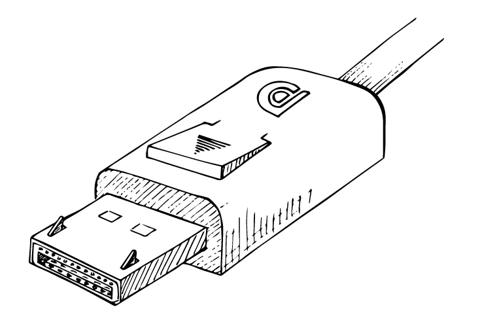DisplayPort connectors have 20 pins. There are two sizes available: the standard DisplayPort and a smaller alternative made by Apple called Mini DisplayPort. The latter is the same port as Thunderbolt.
Though most full-size DisplayPort connectors have a locking mechanism that prevents them from being disconnected accidentally, this feature is not required by the official specification.
Resolution and bandwidth
Every new version of both the HDMITM and DisplayPort standards typically introduce some minor new features, and higher resolution and bandwidth.
This however does not mean that a new display always supports the latest version of the standard. It doesn't make much sense to include a standard that supports 8K resolution on an HD display. The most important thing is that the standard matches the needs of the display. If not, you will be paying more for something you cannot use.
Today’s most common version (for video wall displays), DisplayPort 1.2, supports video resolutions of up to 3840 x 2160 pixels, at a refresh rate of 60 Hz. The official name for this resolution is by the way UHD, but the term 4K is often used as well. In the movie industry 4K implies a resolution of 4096 x 2160, by the way. It also supports all common 3D video formats. The maximum bandwidth to be sent through a DP 1.2 cable is 17.28 Gbps. DisplayPort 1.4, supporting 5120 x 2800 @60Hz at a bandwidth of 25.92 Gbps, is becoming increasingly popular.
The most used HDMITM-version, HDMITM 2.0, features UHD resolution at 60 Hz and a bandwidth of 14.4 Gbps[1]. In other words, it is more important to look at the version number (on both the source and the display) than to compare DisplayPort with HDMITM.
- It is more important to look at the version number (on both the source and the display) than to compare DisplayPort with HDMITM.
Meanwhile, HDMITM 2.1 has been launched, supporting 4K at 120 Hz or 8K at 60 Hz, and offering 48 Gbps speeds. Although not common, this standard is already used in some top-end models (e.g. gaming monitors). DisplayPort 2.0, boasting 10,240 x 4320 resolution and a whopping 77.4 Gbps bandwidth is available as well, but today no models on the market use this standard.
Audio features: facing the music
Both HDMITM and DisplayPort support up to 8 digital audio channels at up to 24 bit and 192 kHz. The main difference is that HDMITM features an audio return channel (ARC). This means that not only the source device (usually an AV-receiver) can send audio to the television set, but sound can flow in the other direction as well.
This can be used when the television has a built-in broadcast receiver (e.g. watching Netflix on a smart-TV), but you don’t want to listen to the sound using the TV’s built-in speakers and prefer the surround sound system of the AV-receiver. Although this is a valuable use case in consumer electronics, it is almost never used in professional AV visualization.





